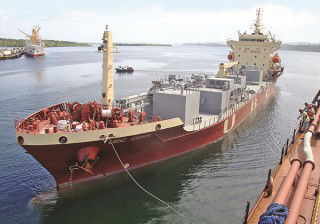On our shipping market the situation is rather similar with the shipyards now full of orders until 2008/2009, companies simply cannot only count on their internal growth to develop their business. However, there will be some “natural” resistance in shipping to a massive wave of mergers, as long as the freight rates will remain at “decent” levels there will be very few candidates for a M&A transaction, except those who are exposed to some hostile takeover on the stock exchanges.
Despite the Chinese holidays, the Capesize market rose slightly towards the end of the week, mainly in anticipation of further activity after the holidays. The general consensus is that the market will firm in the short term due to a possible surge in demand in March, but medium term expectations are less confident with an increasing supply of tonnage and a less buoyant demand being predicted. Period chartering has seen some activity, with a 150,000dwt being rumoured to have been fixed for 12 months for under US$24,000. The market enjoyed a happy time and kept going upward the whole week in a small but steady pace. Even during the Chinese Spring festival vacation the market recovered a bit from it’s previously weak condition. Due to the unclear iron ore price negotiations, the steel mills are very cautious, but still think the freight in 2006 should be in a downward trend because they thought there will be an oversupply on the Capesize. 2 new built Capes have been sold at about 66 million each, maybe another sign of less confidence on the owner’s side. At least some owners won’t be as ambitious as before, and will be willing to accept a very aggressive coa rate for backhaul cargoes in the second half of 2006.
After several weeks of a real free fall, the Panamax index has finally shown signs of a pause. The Atlantic did suffer a lot once again last week, especially from the US Gulf where there were simply no cargoes available for a quite large number of ships. Vessels in this area could only escape by accepting rates in the low US$10,000’s to stay in the Atlantic. The Pacific seemed to be a lot more well balanced, and modern tonnage could hardly hold on to rates nearing US$16,500 for Nopac rounds, while few short period deals were negotiated between US$15,500 and US$16,500, depending on duration.
Rates concerning the Handymax market stopped falling mid last week in the Pacific (following Cape and Panamax trends) namely for modern larger units, with some short period fixtures reported in the region of US$15,000, for instance Arran trader 48,200 mts dwt grabber delivery Far East for 4/6 months at US$14,750 or Yuang Ning sea 48,000 mts dwt delivery Far East for 5/7 months at US$15,000. Meanwhile the Atlantic, namely the US Gulf market, has remained very weak with very limited fixtures reported, but 42,000 dwt 15/20 years cannot expect more than US$10,000 (without ballast bonus) for t/c trip US Gulf to the Med or continent and 27/28,000 dwt modern units have to face old time levels of US$8,000 for such a trip.
Source: Barry Rogliano Salles, Shipbrokers, Paris


